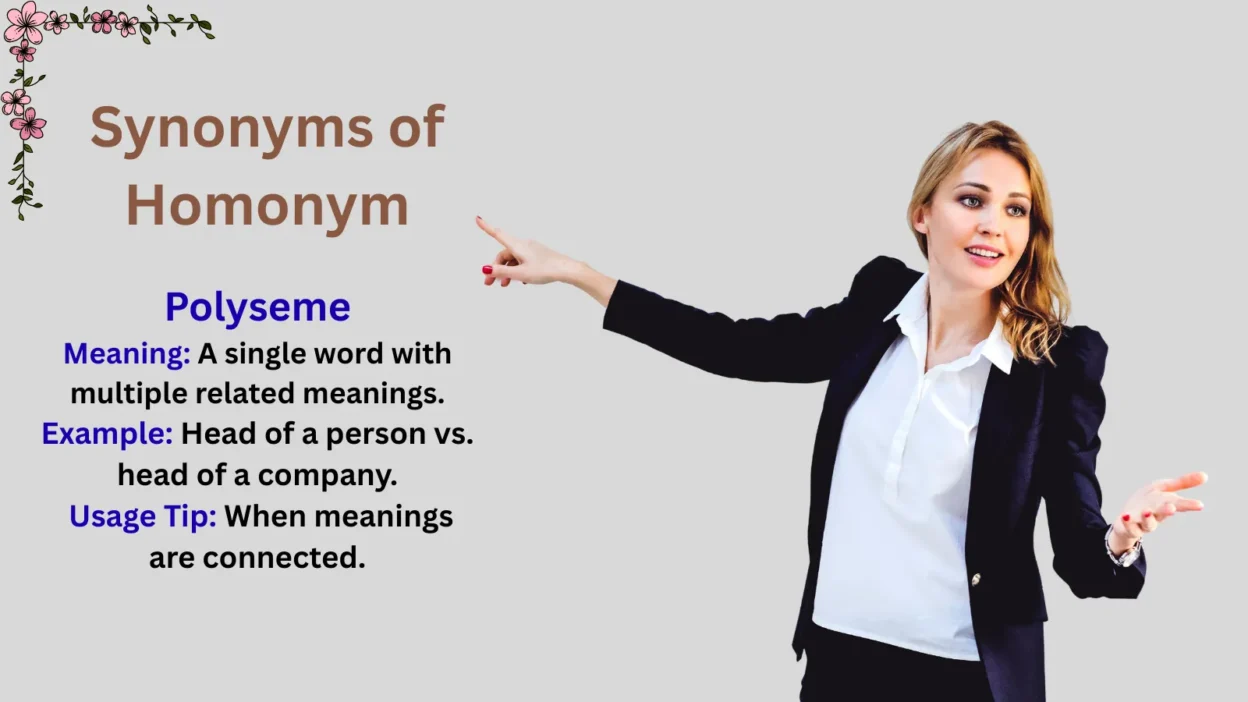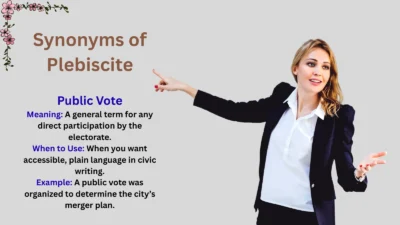Synonyms of homonym help you describe words that sound alike or look the same but have different meanings, without always relying on the term “homonym” itself. Homonyms can be tricky—they include words that sound identical (homophones) or words that share the same spelling but differ in meaning and pronunciation (homographs).
Sometimes, choosing a more precise or context-appropriate term makes your writing clearer, more engaging, or even playful. From technical options like homophones and heteronyms to fun linguistic terms like puns or mondegreens, there’s a rich variety to explore.
In this article, we’ll break down 30 synonyms of homonym, giving definitions, example sentences, and guidance on when each word is most suitable. By the end, you’ll know exactly which term to pick for your writing style and context.
What Exactly Is a Homonym?
A homonym is a word that sounds like another word or is spelled the same but has a different meaning. There are two key categories:
- Homophones: Same sound, different spelling and meaning (e.g., pair and pear).
- Homographs: Same spelling, different pronunciation or meaning (e.g., lead the verb vs. lead the metal).
So while “homonym” is sometimes used broadly, it technically refers to either or both of these confusing creatures, depending on who you ask (yep, even linguists debate it).
Let’s now take a detour to 30 words you might reach for instead of “homonym”—either to be more specific, sound smarter, or tailor your tone.
30 Alternatives to the Word “Homonym” and When to Use Them
1. Homophone
Definition: Words that sound the same but have different meanings and spellings.
Example: Flour and flower are homophones.
When to Use: When you want to highlight pronunciation confusion.
2. Homograph
Definition: Words spelled the same but pronounced differently and have different meanings.
Example: Tear (rip) and tear (from your eye).
When to Use: When talking about spelling but not pronunciation.
3. Polyseme
Definition: A single word with multiple related meanings.
Example: Head of a person vs. head of a company.
When to Use: When meanings are connected.
4. Auto-antonym
Definition: A word that is its own opposite.
Example: Dust (to remove dust vs. to apply it).
When to Use: For clever wordplay or linguistic analysis.
5. Paronym
Definition: Words that are similar in form but different in meaning.
Example: Affect and effect.
When to Use: For grammar or usage explanations.
6. Capitonym
Definition: A word that changes meaning when capitalized.
Example: March (the month) vs. march (to walk).
When to Use: In writing or editing contexts.
7. Heteronym
Definition: A type of homograph with different pronunciations.
Example: Bass (fish) vs. bass (instrument).
When to Use: When sound and meaning both differ.
8. Oronym
Definition: A string of words that sounds like another string.
Example: Ice cream vs. I scream.
When to Use: In speech or puns.
9. Malapropism
Definition: A word misused in place of a similar-sounding one.
Example: He is the pineapple of politeness.
When to Use: For humor or highlighting language errors.
10. Mondegreen
Definition: A misheard lyric or phrase.
Example: Excuse me while I kiss this guy (instead of kiss the sky).
When to Use: In pop culture or auditory confusion.
11. Eggcorn
Definition: A misheard word or phrase that still makes some sense.
Example: For all intents and purposes instead of intents and purposes.
When to Use: Casual language discussions.
12. Synonym
Definition: Words with similar meanings.
Example: Big and large.
When to Use: Not directly related to homonyms, but often confused.
13. Antonym
Definition: Words with opposite meanings.
Example: Hot and cold.
When to Use: When clarifying meaning via contrast.
14. Contronym
Definition: Another term for auto-antonym.
Example: Left (departed) vs. left (remaining).
When to Use: In clever or ironic writing.
15. Pseudohomophone
Definition: Non-words that sound like real words.
Example: Brane for brain.
When to Use: In linguistics or spelling bee contexts.
16. Allonym
Definition: A name assumed by an author, different from their own.
Example: Mark Twain for Samuel Clemens.
When to Use: In literary discussions.
17. Anagram
Definition: Rearranged letters to form a new word.
Example: Listen → Silent.
When to Use: For wordplay or puzzles.
18. Pun
Definition: A joke exploiting word ambiguity.
Example: Time flies like an arrow; fruit flies like a banana.
When to Use: Humor and creativity.
19. Palindrome
Definition: Words that read the same backward.
Example: Racecar.
When to Use: Word games or poetic symmetry.
20. Metonym
Definition: Using a related word as a stand-in.
Example: The crown for monarchy.
When to Use: In figurative language.
21. Eponym
Definition: A word derived from a person’s name.
Example: Sandwich from the Earl of Sandwich.
When to Use: In history or naming discussions.
22. Toponym
Definition: A word derived from a place.
Example: Champagne from the Champagne region in France.
When to Use: Geographic or cultural contexts.
23. Borrowed Word
Definition: A word taken from another language.
Example: Déjà vu.
When to Use: In cross-cultural writing.
24. False Friend
Definition: A word that looks similar in two languages but means something different.
Example: Actual (Spanish: real).
When to Use: Language learning contexts.
25. Neologism
Definition: A newly coined word.
Example: Selfie.
When to Use: Pop culture or technology talk.
26. Acronym
Definition: A word formed from initial letters.
Example: NASA.
When to Use: Business or science writing.
27. Blend Word
Definition: A word formed by combining two words.
Example: Brunch (breakfast + lunch).
When to Use: For modern, casual terms.
28. Portmanteau
Definition: A fancy way to say “blend word.”
Example: Smog (smoke + fog).
When to Use: Same as above, but when sounding fancy matters.
29. Colloquialism
Definition: Informal or conversational words.
Example: Gonna instead of going to.
When to Use: In casual speech or writing.
30. Slang
Definition: Informal words used within a group.
Example: Lit, ghosted.
When to Use: To reflect modern or generational tone.
How to Choose the Right Word
Selecting the best synonym for a homonym depends on:
- Purpose of your writing: Technical writing loves homophones, while casual blogs might prefer puns or mondegreens.
- Tone: Use polyseme or contronym in more analytical or clever contexts.
- Clarity needs: If you’re explaining grammar or giving a lesson, choose precise terms like homophone or paronym.
- Humor vs. education: Puns, eggcorns, and malapropisms are great for fun writing; heteronyms and oronyms serve learning better.
Conclusion:
Exploring synonyms of homonym gives you a richer vocabulary to discuss words that sound alike or look alike but differ in meaning. Whether you choose a homophone, a heteronym, a polyseme, or even a pun, each alternative adds precision, clarity, or playfulness to your writing.
Using these terms thoughtfully ensures your readers understand exactly what type of word confusion or linguistic nuance you mean, while also keeping your content engaging, accurate, and stylistically varied.



